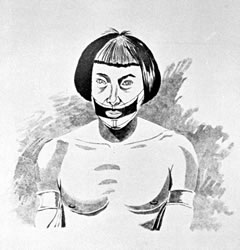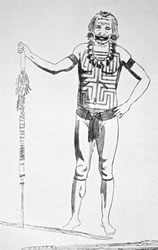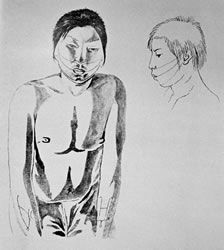THE KAYABI
The Xingu River is the fourth largest tributary of the Amazon River and its many arms fan out across the heart of Mato Grosso state in western Brazil. During the rainy season (December to May), the Xingu valley looks and feels like a hot and humid rainforest. But during the dry season (May to November) when I visited, the region resembles a scrubby-savannah environment and the rivers seldom reach four feet in depth. Sand-beaches and sand-bars emerge in the river and on its banks, and morning mists obscure the jungle beyond the river’s edge.
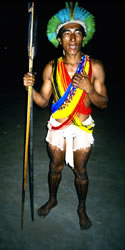 |
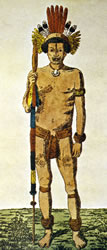 |
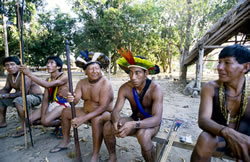 |
Jemy proudly displays intricate body paint and elaborate featherwork that resembles early 19th-century drawings of Apiaká warriors. The Apiaká were traditional enemies of the Kayabi, but today they intermarry. In the past, Apiaká men were tattooed by women who used thorns from the tucum palm. The pattern consisted of three lines extending from each ear, one to a little below the nose, one to a corner of the mouth, and one to the chin. At the age of 14, the tattooing was completed with a rectangle around the mouth, a symbol that the wearer could eat human flesh. The designs tattooed on the body are said to have illustrated their war and hunting deeds, but I believe they were name glyphs like the ones placed on this warrior’s thighs. Photograph © Lars Krutak 2007-2010 |
From right to left, shaman Tuiarajup, chief Jywapãn, elder Javari, aspiring tattooist Jemy, and an unidentified Kayabi man take a break from the afternoon jungle heat. Tuiarajup uses a jaguar bone whistle to communicate with the spirit world; it never leaves his neck. The jaguar is considered to be one of the most powerful animals living in the Xingu. It is associated with the sun, and Xingu chiefs and shamans often wear jaguar-skin headbands, armbands, or belts to associate themselves with this powerful predator. Photograph © Lars Krutak 2007-2010 |
Despite several centuries of contact with Europeans, the region surrounding the Xingu has been home to over a dozen groups of Amerindians spread out over an enormous expanse of woodlands, scrub, swamps, and alligator and piranha-infested rivers. In 1961, much of the region was designated as the Parque Indígena do Xingu, an indigenous reserve comprising some 6.9 million acres of land that today houses some 5,500 inhabitants, including 1,000 Kayabi, from 17 different tribes. (By comparison, over 11,000 Indians including the Guarani live in a much smaller 8600 acre reserve further south on the outskirts of Dourados.)
|
|
Collectively, all of the people who live in the Xingu Reserve, which is the size of Israel, are known as Xinguanos. To safeguard them from epidemics and social disorganization brought by “contact” with outsiders, the reserve is closed to any outside development, such as ranching, farming, mining, or tourism. Missionaries have also been prohibited. As a result, the park has had a history of being relatively well protected from interests that freely operate in other frontier areas of Brazil, like Dourados, allowing the different tribes that reside here to maintain their traditional way of life. This includes holding their ceremonies, speaking their languages, and maintaining their cultural values. |
From the standpoint of tattoo history, however, the Xingu Indigenous Park is perhaps one of only two areas in South America (the other is near where the borders of Colombia, Peru, and Brazil meet) where you can find at least two indigenous groups that continue to tattoo today: the Ikpeng and the Kayabi.
However, not all of the groups that live in the Xingu Reserve traditionally lived here. The Kayabi began moving to the territory from Pará state and the Rio dos Peixes region of western Mato Grosso as early as the late 1950s to evade persecution from rubber tappers, loggers, farmers, miners and other Euro-Brazilians who forced them from their lands, raped their women, or murdered them. Today, approximately 200 Kayabi still live in their traditional homelands outside of the Xingu Reserve, but they are slowly becoming integrated into blanco culture in a mix of poverty and hate. They endure there because this is where most of their ancestors are buried and they insist that they must remain behind to protect the spirits of their ancestors from “vanishing” from this world.
Before the Kayabi migrations, all of the groups in the Xingu were more or less at war with one another. But following the active suppression of warfare and headhunting in the area in the years following World War II, intertribal ties increased and now they remain stronger than ever. Of course, all of the Xinguanos rapidly lost their anger against their former enemies because they knew that the reserve was the only place in the world where they were going to survive, grow their families, and keep their culture more or less intact. The formation of the reserve has had a significant role in keeping the peace among the various indigenous groups living in the Xingu valley, and in fact many groups now intermarry with several of their former enemies.
Traditional Warfare
The Kayabi were probably first contacted by the French naturalist Francis de Castelnau during his expedition to Brazil in the 1840s. From that point forward, they were characterized as very “warlike” and “indomitable” Indians who as an isolated tribe were willing to kill intruders to defend their lands, their people, and to avenge the murder or abduction of their family members.
Traditionally, their most feared enemies were two tribes that also practiced tattooing and to some degree ritualistic cannibalism: the Mundurucú and Apiaká. Although all of these groups were fearsome headhunters, the Mundurucú, who were called “father knife” and “head-cutters” by early Neo-Brazilians, were famous throughout the Amazon for the stuffed trophy heads they created from their enemies. On the other hand, the Apiaká, who are very close linguistic and cultural relatives of the Kayabi, were easily distinguished by the black rectangular tattoo placed around men’s mouths after they had earned the right to eat human flesh – a practice that was supposed to instill in them a spirit of courage.
More specifically, the Apiaká quartered the bodies of their enemies killed in battle, irrespective of sex, and roasted them. The prisoners that were led to the village were eaten with elaborate ceremony by all of the people of the village. If enemy children were captured during a raid, they were brought up together with the tribe’s own children and tattooed in the Apiaká style. However, at the age of twelve or fourteen, the young captives were sacrificed ceremonially within the circle of the gathered tribe. The children’s foster fathers broke their skulls by striking them from behind with a heavy war club. The bodies were then roasted and eaten during an all-night feast. Captured enemy women suffered the same fate after cohabitating with their Apiaká husbands for some four or five years.
|
After a Kayabi warrior had killed his enemy, he usually brought back the victim’s head to the village. It was suspended from a pole by cotton string and as the victor danced into the village and sang songs of victory he was also ornamented with body paint to symbolize his enemy: white paint represented an Apiaká foe; red and black paint represented enemies from other tribes. Afterwards, the head was impaled on a stake and placed in the ground for all to see. Later, the trophy head was boiled in a pot and the meat was consumed by Kayabi warriors and elders of the tribe to give them spiritual strength. |
Page excerpted from Jemy’s tattoo book showing an Apiaká woman’s thigh tattoo called Kwasiaruu that was taken by a Kayabi warrior who killed her.
The book contains over one-hundred tattoo designs, and approximately fifty for the face alone. His book has been bound and distributed to all of the Kayabi in his village so that they can share, learn, and keep it in their memories. Photograph © Lars Krutak 2007-2010
|
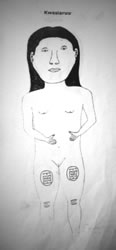 |
Kayabi warriors who had taken human lives were believed to enter into an intimate relationship with their victims. A powerful Kayabi shaman (pajé) named Tuiarajup told me: “you definitely take an enemy’s soul when you kill him. Also, the blood of the dead man begins filling your stomach which necessitates a special diet and ritual seclusion to avert spiritual ‘poisoning’ and physical transformation.” But before the warrior went into seclusion, he was entitled to have the name of his victim tattooed upon his body: “This tattoo symbol represents the new soul that he has gained as well as its spiritual power,” Tuiarajup said.
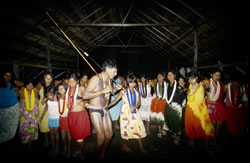 |
Sometimes the name appeared as a tattooed glyph upon the head of the victim; in other cases, these names appeared on another body part. Either way, the symbol was mentally recorded by the Kayabi warrior – unless it was present on the trophy head that was brought back to the village – and repeated to the village’s tattoo master who knew every name associated with the tattooed glyphs of his people’s enemies. Of course, if a Kayabi warrior killed an enemy woman during a raid, he could bring her head back to the village as well as her name and pass it on to his wife, sister, or daughter. |
The Kayabi shaman Tuiarajup leads a Jawosi dance in the community hut. Today, these all-night occasions, which can last up to several weeks, are celebrated to mark the beginning of another male initiation cycle. The shaman carries his war equipment and sings songs that recount the deeds of his ancestors on the battlefield. |
Next Page | 1
|
2 |
3 |
4 |
5 |
6 |
7 |
8 |
Museum photo gallery of the images
on this page may be seen here. |




